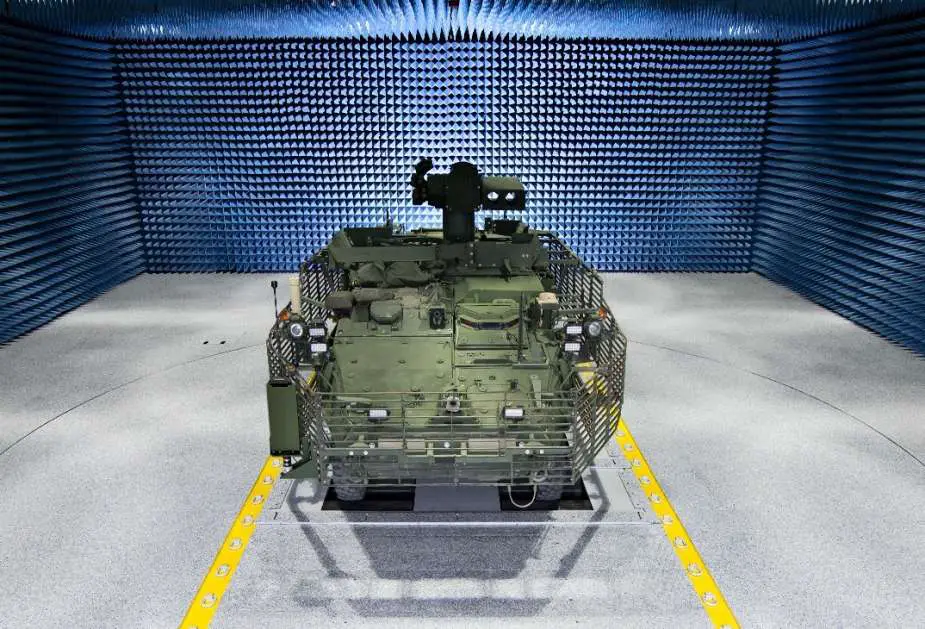Traditionally, wars are fought over land, sea, and in the air. Future conflicts will no longer exist solely in those domains: the armed forces will encounter conflict in space, cyberspace and simultaneously across all five domains. How will the U.S. Army be ready for multi-domain operations? Test for multi-domain operations — using distributed live, virtual and constructive simulations. Deirdre Cascardo reports.
Follow Army Recognition on Google News at this link

Electromagnetic Environmental Effects (E3) Dynamometer, pictured here, is capable of open-air and simulated testing as well as integration within the multi-domain test environment (Picture source: U.S. Army)
On October 19th, 2023, the U.S. Aberdeen Test Center served as one of two locations to witness the initial operating capability of the U.S. Army Test and Evaluation Command’s Multi-Domain Operations Test Environment (ATEC). “This capability is the keystone of the Modernization Task Force effort”, said Dr. Melissa Steffen, ATC’s Technical Director. “We developed a capability to ensure our Army is interoperable and our systems work together”.
The event leveraged network technologies of the Test Resource Management Center to execute a division-level live, virtual, constructive, or LVC, multi-domain operation test scenario (land, air, cyber) with over 60 tactical and virtual assets as well as EW and cyber threats.
The LVC playbox contained approximately 3,000 blue force and opposing forces entities synchronized through a distributed nationwide across six of ATEC's developmental test centers, the U.S. Army Operational Test Command, and the U.S. Army Evaluation Center. The initial operating capability showcased ATEC's modernized digital data environment and capability to test in a distributed environment with live and virtual assets.
The capability was rapidly conceptualized and brought online in nine months to answer the call for a multi-domain testing capability and to support the Army of 2030 against evolving enemy threats. “Although this is a large-scale effort across the ATEC enterprise, ATC contributes a multitude of physical ground platforms, expertise, instrumentation and hardware-in-the-loop facilities like the electromagnetic environmental effects dynamometer, and the moving target simulator; both capable and well suited to integrate live systems in a constructive simulation to achieve the scale needed to support MDO testing,” said Paul Weimer, division chief of ATC’s Cyber & Electromagnetic Activities Division.
Initial capability objectives were very ambitious, but ATEC met those goals and derived scalability benefits in the process. Achieving connectivity on a large scale proved connectivity between test centers’ tools and assets — virtual or fixed — that are accessible to each test center. “We definitely learn things as we go,” said Beth Pelletier, lead for ATC’s Distributed Test Control Center. “It’s impressive and exciting to see real things interacting with virtual things in other places. This removes geographical and physical barriers to testing, which brings huge cost savings. It’s nothing but a benefit and we can see the future of testing.”
Although distributed testing does not replace live, physical testing, it does provide versatility and benefits to testing at scale. Testing in a real environment informs parameters that can be used in modeling and simulation to test at a significantly larger scale that would be cost-prohibitive to test in real life.
“During MDO testing, it’s powerful to see how an effect on one entity can influence the whole tactical operation. Traditionally, in developmental testing, you’re limited to seeing the effects of a given threat to a system under test, but now, through the use of distributed LVC we are able to see threat effects and the impact to the larger entire operation — that’s critical for assessing performance in a system-of-systems MDO environment, especially for threats that cannot be exercised in a traditional live operational test,” said Weimer.
Providing quality data to decision-makers to enable our U.S. Warfighters, has always been ATC’s mission. By supporting ATEC’s MDO testing, ATC will collaborate with other test sites to provide more robust data for decision-makers. “MDO testing allows the Army to shift left, supporting earlier Soldier engagement and experimentation”, said Camille Houston, Director of ATC’s Virtual Test and Advanced Electronics Directorate. “It also provides early insights into system interoperability on the battlefield. As we look to Army 2030 and beyond, the agility and adaptability of distributed testing will pave the way for more mission-based T&E.”
Defense News December 2023















